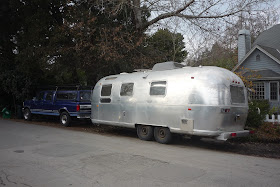One of the common tasks with older Airstream trailers is replacing the rubber torsion axles. Evidently, if the trailer is not used for long periods of time the rubber rods inside the suspension units harden and the trailer loses much of its suspension. This is hard on the trailer and contents, and will lead to popped rivets, leaks, etc. if not addressed. Here's a drawing of the axle on these Airstreams:
We knew we would likely need to replace the axles from our readings of the very helpful posts on Airforums.com. One give away was the low ride height of the trailer, seen here on the day we brought her home:
There is more information on diagnosing axle problems here: http://inlandrv.com/articles/dura-torqe-axle-92001.html
The other decision we had to make was whether to replaced the axles with the same configuration - 12" electric drum brakes - or switch to hydraulic disc brakes with a electrically driven hydraulic brake pump. We decided to go ahead with the disc brakes since they provide much more powerful and fade resistant stopping, and require significantly less maintenance than drum brakes as periodic adjustment is not required, only periodic inspection. I ordered axles, new shocks, Centrematics (self balancers) and disc brake kits from Andy at Inland RV and they arrived in less than two weeks. I had them shipped to my workplace, where a handy loading dock saved significant freight costs. After getting some help wrestling them into the truck, I brought them home.
Airstream trailers are of largely monocoque construction; large point loads need to be applied at designed points to prevent damage. In particular, when jacking up the trailer or supporting it on jackstands, the lifting points should be the large vertical axles mounting plates:
Axle and shock mounting bolts were somewhat
rusty. |
Axle replacement turned out to be quite simple; I assembled the rotors and caliper mounting brackets on the axles, and then removed and replaced the old axles. They're fairly heavy, so either clever use of a jack or a helper is a good idea. Some pictures of the axle assembly process:
Metal sawhorses saved my back a lot of
leaning over... |
Assembling well-greased bearings.....
|
Note disc brake rotor, caliper mounting arm.
|
I switched axles one at a time, just in case.
|
Once the axles were mounted and the Tin Pickle was once again sitting on her geriatric Michelin radials, I started on mounting the calipers, running brake lines, etc. This part took a while; of course, those not using disc brakes would now hook up 8 wires and be done.
Once this was done, I installed the Carlisle "Hydrastar" brake actuator, which converts the variable current coming from our truck's Prodigy brake controller to varying hydraulic pressure (up to 1600 psi) to actuate the GM disc brakes on the Kodiak disc brake conversion kits on the trailer . The Hydrastar required repeated bleeding; I did this by myself by wiring a switch to the break-away wiring so I could get the pump going while manipulating the caliper bleeding valves. Since the Hydrastart was in the trailer, I'd have to crawl out after bleeding each wheel to refill the master cylinder. A pressure bleeder would definitely save time.
Once this task was complete, the trailer brakes worked very well indeed - so much so that it seems the truck stops faster with the trailer attached than not. Once the brakes were working, it was off to 5 Point Tire in Redwood City for a new set of Michelin radials.







genius. This is some choice work. Fantastic
ReplyDelete